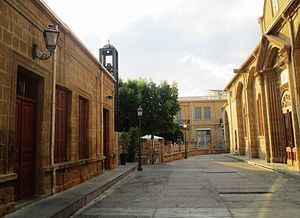Type public, historical | ||
 | ||
Faneromeni Square (Greek: Πλατεία Φανερωμένης Turkish: Faneromeni Meydanı ), is an important historical square located within the Venetian walls of Nicosia.
Contents
- Play me i m yours nicosia 2014 faneromeni square in the mirror
- Overview and historical background
- References
It hosts a number of historical buildings and monuments including Faneromeni Church, Faneromeni School, Faneromeni Library,and the Marble Mausoleum.
Play me i m yours nicosia 2014 faneromeni square in the mirror
Overview and historical background
Faneromeni Square was the centre of Nicosia before Eleftheria Square took over in 1974.
Faneromeni Church dominates the centre of the square and was built in 1872 on the site of an ancient Orthodox nunnery. The church is dedicated to Holy Mary and it is the largest church within the city walls of Nicosia. Architecturally the Church edifice features a mixture of Neoclassical, Byzantine and Medieval Latin styles.
Faneromeni School, founded by Archbishop Makarios I in 1857, was the first all-girls school in Cyprus in an attempt to combat the then high illiteracy rates across the island.
The Marble Mausoleum on the eastern side of Faneromeni Church is situated on the front of the building and was built in memory of four clerics executed by the Ottoman governor in 1821, following the Cypriot revolt due to the newly declared Greek War of Independence.
The square is surrounded by several neoclassical buildings featuring predominantly Greek, as well as, local Cypriot architectural influences. These include the Faneromeni Library.
Today the square is a meeting point for the anarchist movement of Cyprus, anti-authoritarians, libertarians, many artists and musicians. It is also a stronghold of the antifascist movement on the island.
